Analysis of Counselling Methods for Young Adults and Peer Pressure
VerifiedAdded on 2020/05/11
|11
|2918
|170
Essay
AI Summary
This essay delves into the critical issue of peer pressure among young adults, exploring the challenges and complexities associated with it. It examines the concept of group counselling, highlighting its benefits in fostering social skills and providing a supportive environment. The essay analyzes real-life issues faced by young adults, including the impact of peer pressure on their decisions and mental well-being, and the challenges they encounter. It then compares and contrasts the pros and cons of both group and individual counselling, offering insights into their respective applications in addressing these issues. Furthermore, the essay introduces Rational Emotive Behavior Therapy (REBT) as a therapeutic approach and discusses its effectiveness in managing peer pressure. The content emphasizes the importance of counselling in helping young adults navigate the pressures they face and improve their overall mental health.
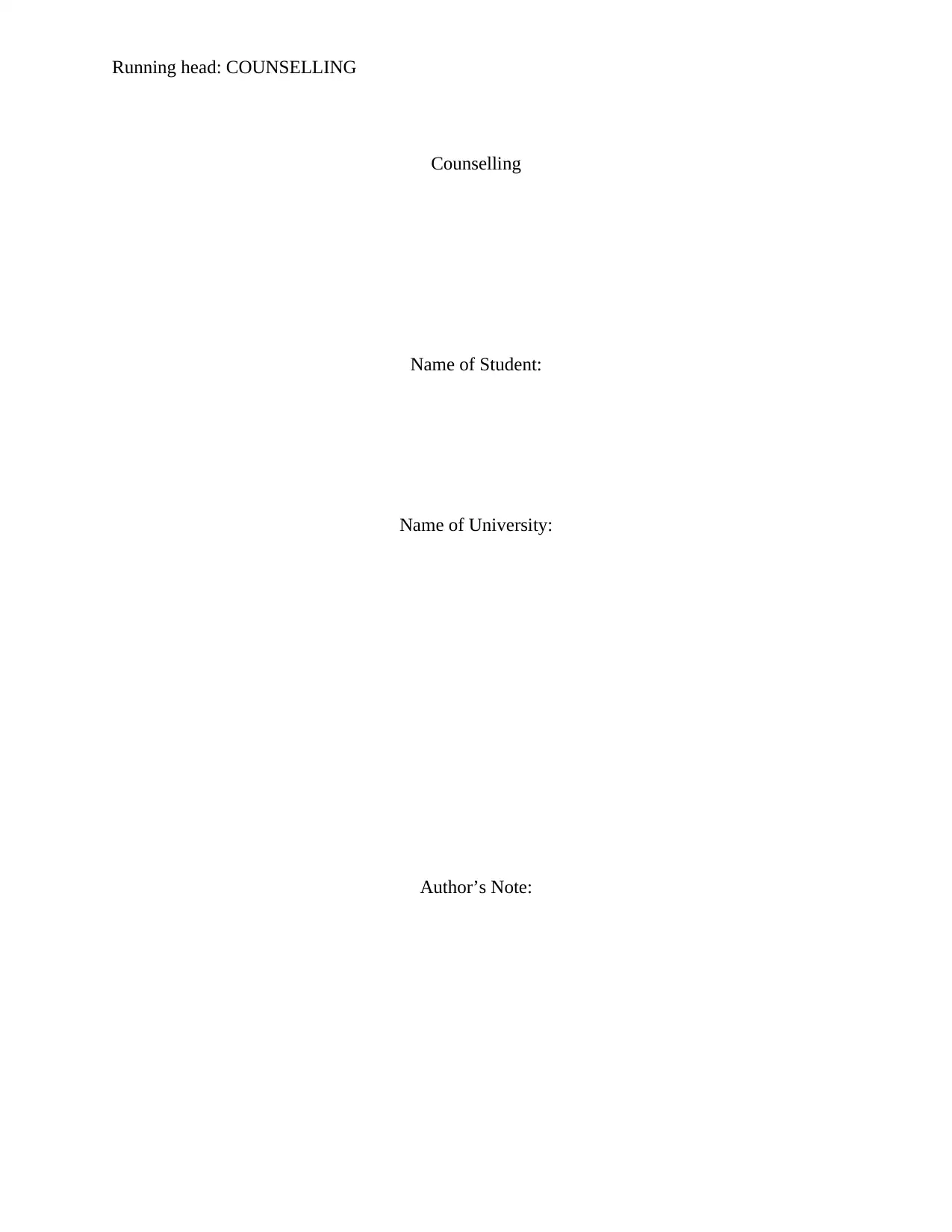
Running head: COUNSELLING
Counselling
Name of Student:
Name of University:
Author’s Note:
Counselling
Name of Student:
Name of University:
Author’s Note:
Paraphrase This Document
Need a fresh take? Get an instant paraphrase of this document with our AI Paraphraser
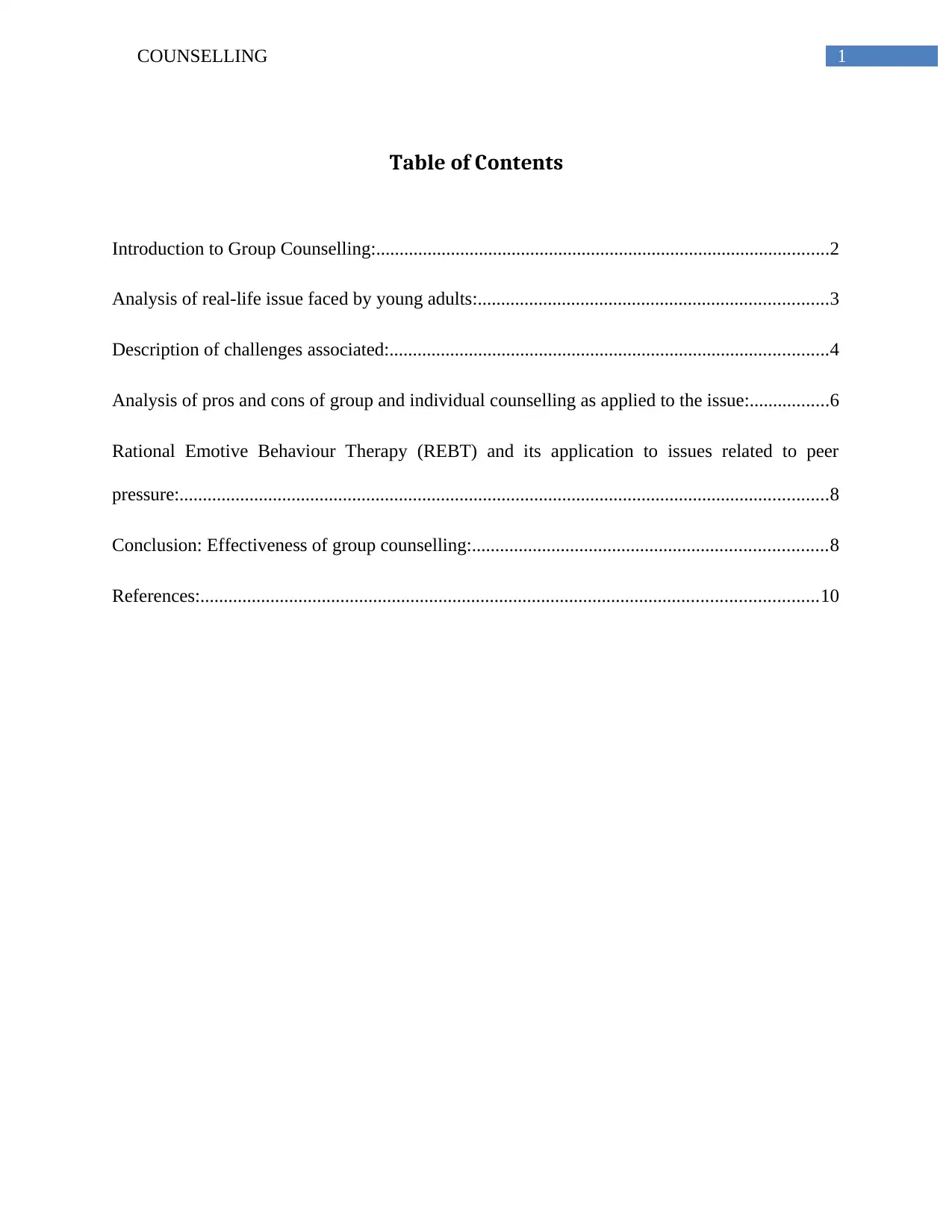
1COUNSELLING
Table of Contents
Introduction to Group Counselling:.................................................................................................2
Analysis of real-life issue faced by young adults:...........................................................................3
Description of challenges associated:..............................................................................................4
Analysis of pros and cons of group and individual counselling as applied to the issue:.................6
Rational Emotive Behaviour Therapy (REBT) and its application to issues related to peer
pressure:...........................................................................................................................................8
Conclusion: Effectiveness of group counselling:............................................................................8
References:....................................................................................................................................10
Table of Contents
Introduction to Group Counselling:.................................................................................................2
Analysis of real-life issue faced by young adults:...........................................................................3
Description of challenges associated:..............................................................................................4
Analysis of pros and cons of group and individual counselling as applied to the issue:.................6
Rational Emotive Behaviour Therapy (REBT) and its application to issues related to peer
pressure:...........................................................................................................................................8
Conclusion: Effectiveness of group counselling:............................................................................8
References:....................................................................................................................................10
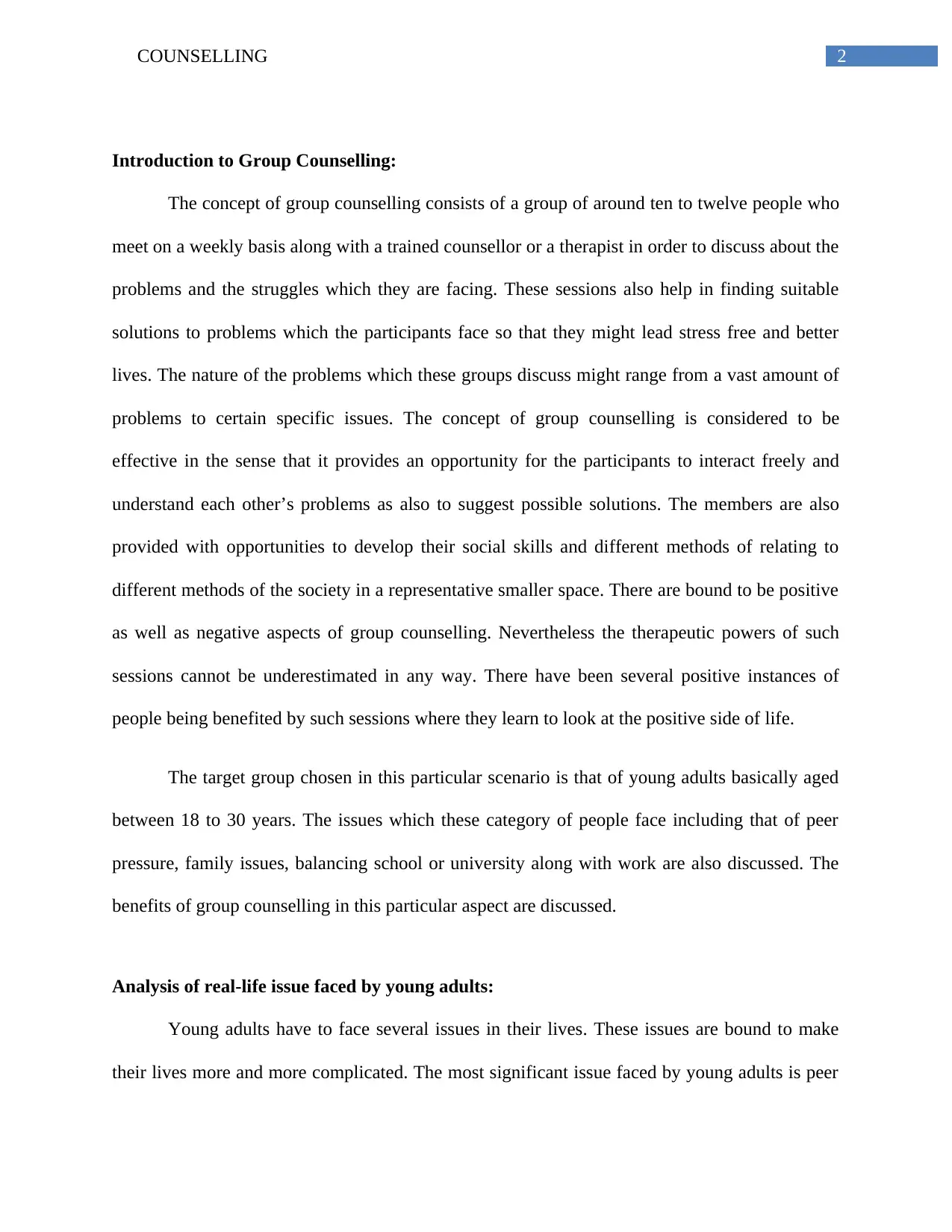
2COUNSELLING
Introduction to Group Counselling:
The concept of group counselling consists of a group of around ten to twelve people who
meet on a weekly basis along with a trained counsellor or a therapist in order to discuss about the
problems and the struggles which they are facing. These sessions also help in finding suitable
solutions to problems which the participants face so that they might lead stress free and better
lives. The nature of the problems which these groups discuss might range from a vast amount of
problems to certain specific issues. The concept of group counselling is considered to be
effective in the sense that it provides an opportunity for the participants to interact freely and
understand each other’s problems as also to suggest possible solutions. The members are also
provided with opportunities to develop their social skills and different methods of relating to
different methods of the society in a representative smaller space. There are bound to be positive
as well as negative aspects of group counselling. Nevertheless the therapeutic powers of such
sessions cannot be underestimated in any way. There have been several positive instances of
people being benefited by such sessions where they learn to look at the positive side of life.
The target group chosen in this particular scenario is that of young adults basically aged
between 18 to 30 years. The issues which these category of people face including that of peer
pressure, family issues, balancing school or university along with work are also discussed. The
benefits of group counselling in this particular aspect are discussed.
Analysis of real-life issue faced by young adults:
Young adults have to face several issues in their lives. These issues are bound to make
their lives more and more complicated. The most significant issue faced by young adults is peer
Introduction to Group Counselling:
The concept of group counselling consists of a group of around ten to twelve people who
meet on a weekly basis along with a trained counsellor or a therapist in order to discuss about the
problems and the struggles which they are facing. These sessions also help in finding suitable
solutions to problems which the participants face so that they might lead stress free and better
lives. The nature of the problems which these groups discuss might range from a vast amount of
problems to certain specific issues. The concept of group counselling is considered to be
effective in the sense that it provides an opportunity for the participants to interact freely and
understand each other’s problems as also to suggest possible solutions. The members are also
provided with opportunities to develop their social skills and different methods of relating to
different methods of the society in a representative smaller space. There are bound to be positive
as well as negative aspects of group counselling. Nevertheless the therapeutic powers of such
sessions cannot be underestimated in any way. There have been several positive instances of
people being benefited by such sessions where they learn to look at the positive side of life.
The target group chosen in this particular scenario is that of young adults basically aged
between 18 to 30 years. The issues which these category of people face including that of peer
pressure, family issues, balancing school or university along with work are also discussed. The
benefits of group counselling in this particular aspect are discussed.
Analysis of real-life issue faced by young adults:
Young adults have to face several issues in their lives. These issues are bound to make
their lives more and more complicated. The most significant issue faced by young adults is peer
⊘ This is a preview!⊘
Do you want full access?
Subscribe today to unlock all pages.

Trusted by 1+ million students worldwide
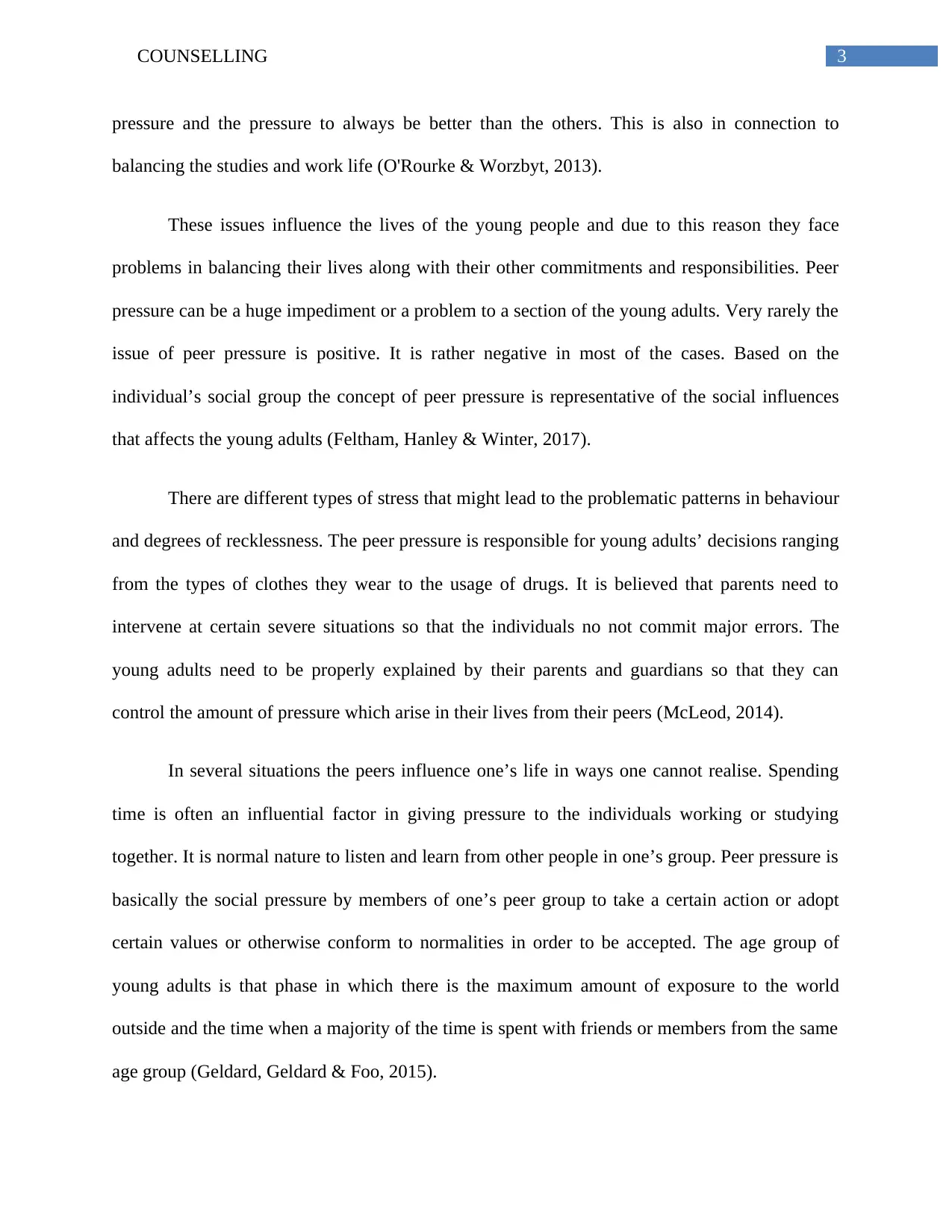
3COUNSELLING
pressure and the pressure to always be better than the others. This is also in connection to
balancing the studies and work life (O'Rourke & Worzbyt, 2013).
These issues influence the lives of the young people and due to this reason they face
problems in balancing their lives along with their other commitments and responsibilities. Peer
pressure can be a huge impediment or a problem to a section of the young adults. Very rarely the
issue of peer pressure is positive. It is rather negative in most of the cases. Based on the
individual’s social group the concept of peer pressure is representative of the social influences
that affects the young adults (Feltham, Hanley & Winter, 2017).
There are different types of stress that might lead to the problematic patterns in behaviour
and degrees of recklessness. The peer pressure is responsible for young adults’ decisions ranging
from the types of clothes they wear to the usage of drugs. It is believed that parents need to
intervene at certain severe situations so that the individuals no not commit major errors. The
young adults need to be properly explained by their parents and guardians so that they can
control the amount of pressure which arise in their lives from their peers (McLeod, 2014).
In several situations the peers influence one’s life in ways one cannot realise. Spending
time is often an influential factor in giving pressure to the individuals working or studying
together. It is normal nature to listen and learn from other people in one’s group. Peer pressure is
basically the social pressure by members of one’s peer group to take a certain action or adopt
certain values or otherwise conform to normalities in order to be accepted. The age group of
young adults is that phase in which there is the maximum amount of exposure to the world
outside and the time when a majority of the time is spent with friends or members from the same
age group (Geldard, Geldard & Foo, 2015).
pressure and the pressure to always be better than the others. This is also in connection to
balancing the studies and work life (O'Rourke & Worzbyt, 2013).
These issues influence the lives of the young people and due to this reason they face
problems in balancing their lives along with their other commitments and responsibilities. Peer
pressure can be a huge impediment or a problem to a section of the young adults. Very rarely the
issue of peer pressure is positive. It is rather negative in most of the cases. Based on the
individual’s social group the concept of peer pressure is representative of the social influences
that affects the young adults (Feltham, Hanley & Winter, 2017).
There are different types of stress that might lead to the problematic patterns in behaviour
and degrees of recklessness. The peer pressure is responsible for young adults’ decisions ranging
from the types of clothes they wear to the usage of drugs. It is believed that parents need to
intervene at certain severe situations so that the individuals no not commit major errors. The
young adults need to be properly explained by their parents and guardians so that they can
control the amount of pressure which arise in their lives from their peers (McLeod, 2014).
In several situations the peers influence one’s life in ways one cannot realise. Spending
time is often an influential factor in giving pressure to the individuals working or studying
together. It is normal nature to listen and learn from other people in one’s group. Peer pressure is
basically the social pressure by members of one’s peer group to take a certain action or adopt
certain values or otherwise conform to normalities in order to be accepted. The age group of
young adults is that phase in which there is the maximum amount of exposure to the world
outside and the time when a majority of the time is spent with friends or members from the same
age group (Geldard, Geldard & Foo, 2015).
Paraphrase This Document
Need a fresh take? Get an instant paraphrase of this document with our AI Paraphraser
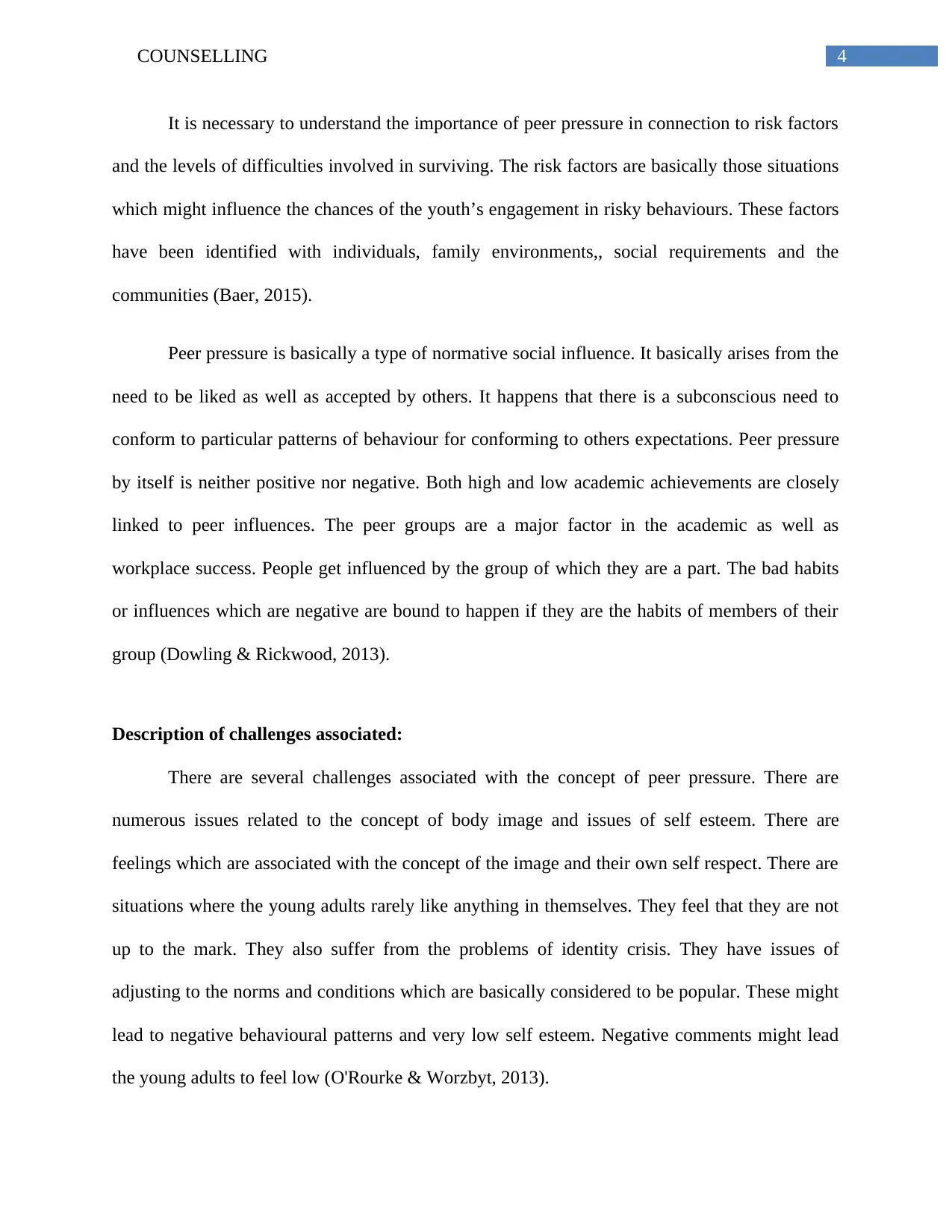
4COUNSELLING
It is necessary to understand the importance of peer pressure in connection to risk factors
and the levels of difficulties involved in surviving. The risk factors are basically those situations
which might influence the chances of the youth’s engagement in risky behaviours. These factors
have been identified with individuals, family environments,, social requirements and the
communities (Baer, 2015).
Peer pressure is basically a type of normative social influence. It basically arises from the
need to be liked as well as accepted by others. It happens that there is a subconscious need to
conform to particular patterns of behaviour for conforming to others expectations. Peer pressure
by itself is neither positive nor negative. Both high and low academic achievements are closely
linked to peer influences. The peer groups are a major factor in the academic as well as
workplace success. People get influenced by the group of which they are a part. The bad habits
or influences which are negative are bound to happen if they are the habits of members of their
group (Dowling & Rickwood, 2013).
Description of challenges associated:
There are several challenges associated with the concept of peer pressure. There are
numerous issues related to the concept of body image and issues of self esteem. There are
feelings which are associated with the concept of the image and their own self respect. There are
situations where the young adults rarely like anything in themselves. They feel that they are not
up to the mark. They also suffer from the problems of identity crisis. They have issues of
adjusting to the norms and conditions which are basically considered to be popular. These might
lead to negative behavioural patterns and very low self esteem. Negative comments might lead
the young adults to feel low (O'Rourke & Worzbyt, 2013).
It is necessary to understand the importance of peer pressure in connection to risk factors
and the levels of difficulties involved in surviving. The risk factors are basically those situations
which might influence the chances of the youth’s engagement in risky behaviours. These factors
have been identified with individuals, family environments,, social requirements and the
communities (Baer, 2015).
Peer pressure is basically a type of normative social influence. It basically arises from the
need to be liked as well as accepted by others. It happens that there is a subconscious need to
conform to particular patterns of behaviour for conforming to others expectations. Peer pressure
by itself is neither positive nor negative. Both high and low academic achievements are closely
linked to peer influences. The peer groups are a major factor in the academic as well as
workplace success. People get influenced by the group of which they are a part. The bad habits
or influences which are negative are bound to happen if they are the habits of members of their
group (Dowling & Rickwood, 2013).
Description of challenges associated:
There are several challenges associated with the concept of peer pressure. There are
numerous issues related to the concept of body image and issues of self esteem. There are
feelings which are associated with the concept of the image and their own self respect. There are
situations where the young adults rarely like anything in themselves. They feel that they are not
up to the mark. They also suffer from the problems of identity crisis. They have issues of
adjusting to the norms and conditions which are basically considered to be popular. These might
lead to negative behavioural patterns and very low self esteem. Negative comments might lead
the young adults to feel low (O'Rourke & Worzbyt, 2013).
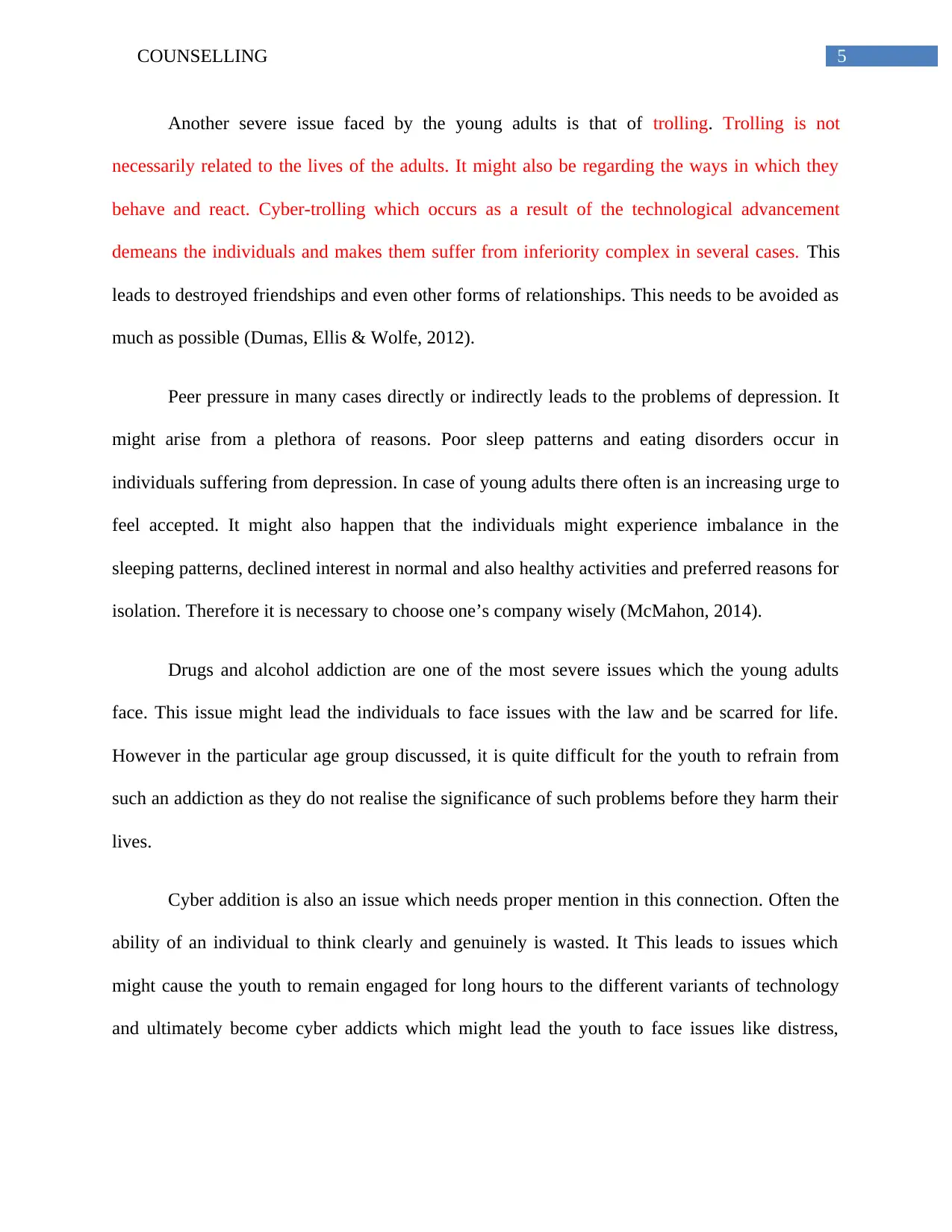
5COUNSELLING
Another severe issue faced by the young adults is that of trolling. Trolling is not
necessarily related to the lives of the adults. It might also be regarding the ways in which they
behave and react. Cyber-trolling which occurs as a result of the technological advancement
demeans the individuals and makes them suffer from inferiority complex in several cases. This
leads to destroyed friendships and even other forms of relationships. This needs to be avoided as
much as possible (Dumas, Ellis & Wolfe, 2012).
Peer pressure in many cases directly or indirectly leads to the problems of depression. It
might arise from a plethora of reasons. Poor sleep patterns and eating disorders occur in
individuals suffering from depression. In case of young adults there often is an increasing urge to
feel accepted. It might also happen that the individuals might experience imbalance in the
sleeping patterns, declined interest in normal and also healthy activities and preferred reasons for
isolation. Therefore it is necessary to choose one’s company wisely (McMahon, 2014).
Drugs and alcohol addiction are one of the most severe issues which the young adults
face. This issue might lead the individuals to face issues with the law and be scarred for life.
However in the particular age group discussed, it is quite difficult for the youth to refrain from
such an addiction as they do not realise the significance of such problems before they harm their
lives.
Cyber addition is also an issue which needs proper mention in this connection. Often the
ability of an individual to think clearly and genuinely is wasted. It This leads to issues which
might cause the youth to remain engaged for long hours to the different variants of technology
and ultimately become cyber addicts which might lead the youth to face issues like distress,
Another severe issue faced by the young adults is that of trolling. Trolling is not
necessarily related to the lives of the adults. It might also be regarding the ways in which they
behave and react. Cyber-trolling which occurs as a result of the technological advancement
demeans the individuals and makes them suffer from inferiority complex in several cases. This
leads to destroyed friendships and even other forms of relationships. This needs to be avoided as
much as possible (Dumas, Ellis & Wolfe, 2012).
Peer pressure in many cases directly or indirectly leads to the problems of depression. It
might arise from a plethora of reasons. Poor sleep patterns and eating disorders occur in
individuals suffering from depression. In case of young adults there often is an increasing urge to
feel accepted. It might also happen that the individuals might experience imbalance in the
sleeping patterns, declined interest in normal and also healthy activities and preferred reasons for
isolation. Therefore it is necessary to choose one’s company wisely (McMahon, 2014).
Drugs and alcohol addiction are one of the most severe issues which the young adults
face. This issue might lead the individuals to face issues with the law and be scarred for life.
However in the particular age group discussed, it is quite difficult for the youth to refrain from
such an addiction as they do not realise the significance of such problems before they harm their
lives.
Cyber addition is also an issue which needs proper mention in this connection. Often the
ability of an individual to think clearly and genuinely is wasted. It This leads to issues which
might cause the youth to remain engaged for long hours to the different variants of technology
and ultimately become cyber addicts which might lead the youth to face issues like distress,
⊘ This is a preview!⊘
Do you want full access?
Subscribe today to unlock all pages.

Trusted by 1+ million students worldwide
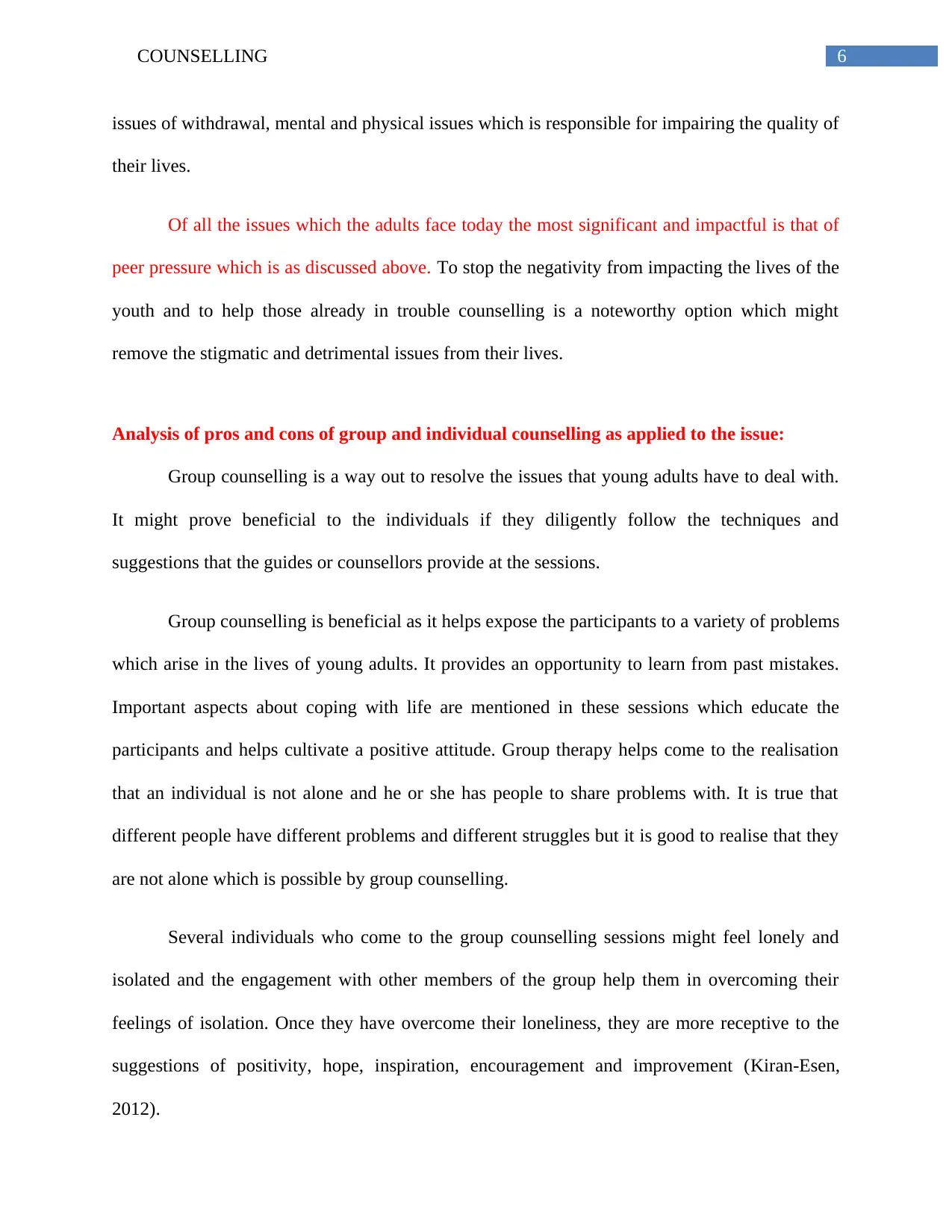
6COUNSELLING
issues of withdrawal, mental and physical issues which is responsible for impairing the quality of
their lives.
Of all the issues which the adults face today the most significant and impactful is that of
peer pressure which is as discussed above. To stop the negativity from impacting the lives of the
youth and to help those already in trouble counselling is a noteworthy option which might
remove the stigmatic and detrimental issues from their lives.
Analysis of pros and cons of group and individual counselling as applied to the issue:
Group counselling is a way out to resolve the issues that young adults have to deal with.
It might prove beneficial to the individuals if they diligently follow the techniques and
suggestions that the guides or counsellors provide at the sessions.
Group counselling is beneficial as it helps expose the participants to a variety of problems
which arise in the lives of young adults. It provides an opportunity to learn from past mistakes.
Important aspects about coping with life are mentioned in these sessions which educate the
participants and helps cultivate a positive attitude. Group therapy helps come to the realisation
that an individual is not alone and he or she has people to share problems with. It is true that
different people have different problems and different struggles but it is good to realise that they
are not alone which is possible by group counselling.
Several individuals who come to the group counselling sessions might feel lonely and
isolated and the engagement with other members of the group help them in overcoming their
feelings of isolation. Once they have overcome their loneliness, they are more receptive to the
suggestions of positivity, hope, inspiration, encouragement and improvement (Kiran-Esen,
2012).
issues of withdrawal, mental and physical issues which is responsible for impairing the quality of
their lives.
Of all the issues which the adults face today the most significant and impactful is that of
peer pressure which is as discussed above. To stop the negativity from impacting the lives of the
youth and to help those already in trouble counselling is a noteworthy option which might
remove the stigmatic and detrimental issues from their lives.
Analysis of pros and cons of group and individual counselling as applied to the issue:
Group counselling is a way out to resolve the issues that young adults have to deal with.
It might prove beneficial to the individuals if they diligently follow the techniques and
suggestions that the guides or counsellors provide at the sessions.
Group counselling is beneficial as it helps expose the participants to a variety of problems
which arise in the lives of young adults. It provides an opportunity to learn from past mistakes.
Important aspects about coping with life are mentioned in these sessions which educate the
participants and helps cultivate a positive attitude. Group therapy helps come to the realisation
that an individual is not alone and he or she has people to share problems with. It is true that
different people have different problems and different struggles but it is good to realise that they
are not alone which is possible by group counselling.
Several individuals who come to the group counselling sessions might feel lonely and
isolated and the engagement with other members of the group help them in overcoming their
feelings of isolation. Once they have overcome their loneliness, they are more receptive to the
suggestions of positivity, hope, inspiration, encouragement and improvement (Kiran-Esen,
2012).
Paraphrase This Document
Need a fresh take? Get an instant paraphrase of this document with our AI Paraphraser
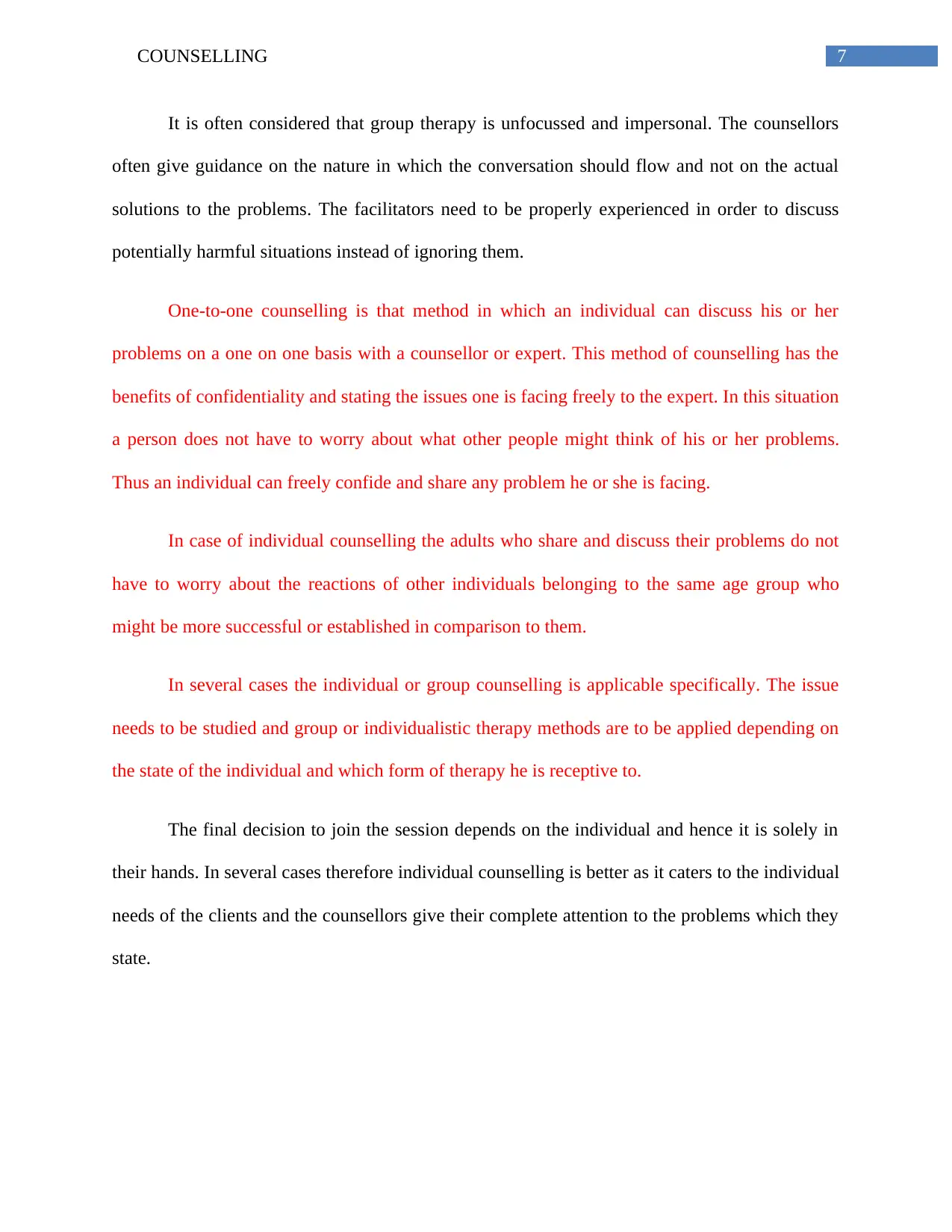
7COUNSELLING
It is often considered that group therapy is unfocussed and impersonal. The counsellors
often give guidance on the nature in which the conversation should flow and not on the actual
solutions to the problems. The facilitators need to be properly experienced in order to discuss
potentially harmful situations instead of ignoring them.
One-to-one counselling is that method in which an individual can discuss his or her
problems on a one on one basis with a counsellor or expert. This method of counselling has the
benefits of confidentiality and stating the issues one is facing freely to the expert. In this situation
a person does not have to worry about what other people might think of his or her problems.
Thus an individual can freely confide and share any problem he or she is facing.
In case of individual counselling the adults who share and discuss their problems do not
have to worry about the reactions of other individuals belonging to the same age group who
might be more successful or established in comparison to them.
In several cases the individual or group counselling is applicable specifically. The issue
needs to be studied and group or individualistic therapy methods are to be applied depending on
the state of the individual and which form of therapy he is receptive to.
The final decision to join the session depends on the individual and hence it is solely in
their hands. In several cases therefore individual counselling is better as it caters to the individual
needs of the clients and the counsellors give their complete attention to the problems which they
state.
It is often considered that group therapy is unfocussed and impersonal. The counsellors
often give guidance on the nature in which the conversation should flow and not on the actual
solutions to the problems. The facilitators need to be properly experienced in order to discuss
potentially harmful situations instead of ignoring them.
One-to-one counselling is that method in which an individual can discuss his or her
problems on a one on one basis with a counsellor or expert. This method of counselling has the
benefits of confidentiality and stating the issues one is facing freely to the expert. In this situation
a person does not have to worry about what other people might think of his or her problems.
Thus an individual can freely confide and share any problem he or she is facing.
In case of individual counselling the adults who share and discuss their problems do not
have to worry about the reactions of other individuals belonging to the same age group who
might be more successful or established in comparison to them.
In several cases the individual or group counselling is applicable specifically. The issue
needs to be studied and group or individualistic therapy methods are to be applied depending on
the state of the individual and which form of therapy he is receptive to.
The final decision to join the session depends on the individual and hence it is solely in
their hands. In several cases therefore individual counselling is better as it caters to the individual
needs of the clients and the counsellors give their complete attention to the problems which they
state.
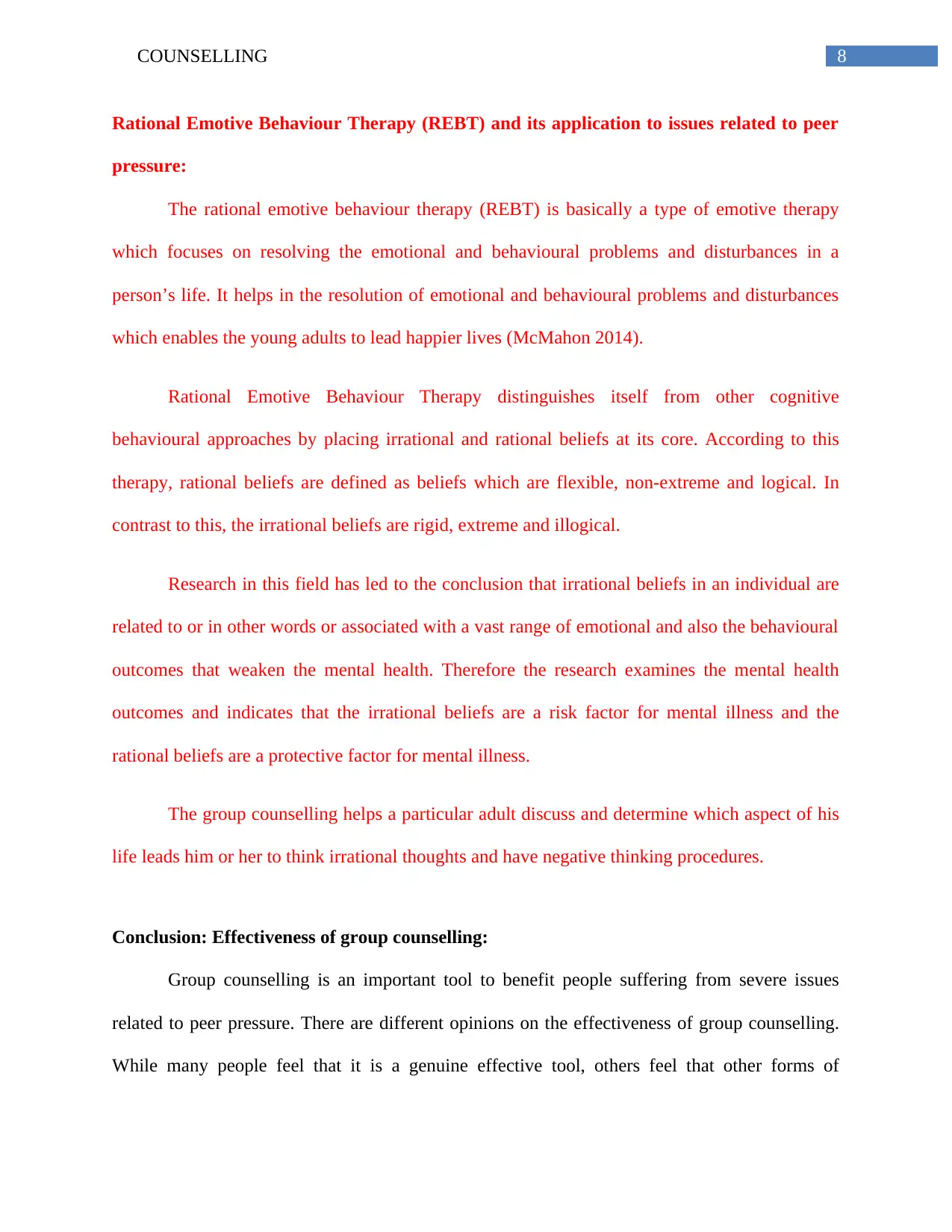
8COUNSELLING
Rational Emotive Behaviour Therapy (REBT) and its application to issues related to peer
pressure:
The rational emotive behaviour therapy (REBT) is basically a type of emotive therapy
which focuses on resolving the emotional and behavioural problems and disturbances in a
person’s life. It helps in the resolution of emotional and behavioural problems and disturbances
which enables the young adults to lead happier lives (McMahon 2014).
Rational Emotive Behaviour Therapy distinguishes itself from other cognitive
behavioural approaches by placing irrational and rational beliefs at its core. According to this
therapy, rational beliefs are defined as beliefs which are flexible, non-extreme and logical. In
contrast to this, the irrational beliefs are rigid, extreme and illogical.
Research in this field has led to the conclusion that irrational beliefs in an individual are
related to or in other words or associated with a vast range of emotional and also the behavioural
outcomes that weaken the mental health. Therefore the research examines the mental health
outcomes and indicates that the irrational beliefs are a risk factor for mental illness and the
rational beliefs are a protective factor for mental illness.
The group counselling helps a particular adult discuss and determine which aspect of his
life leads him or her to think irrational thoughts and have negative thinking procedures.
Conclusion: Effectiveness of group counselling:
Group counselling is an important tool to benefit people suffering from severe issues
related to peer pressure. There are different opinions on the effectiveness of group counselling.
While many people feel that it is a genuine effective tool, others feel that other forms of
Rational Emotive Behaviour Therapy (REBT) and its application to issues related to peer
pressure:
The rational emotive behaviour therapy (REBT) is basically a type of emotive therapy
which focuses on resolving the emotional and behavioural problems and disturbances in a
person’s life. It helps in the resolution of emotional and behavioural problems and disturbances
which enables the young adults to lead happier lives (McMahon 2014).
Rational Emotive Behaviour Therapy distinguishes itself from other cognitive
behavioural approaches by placing irrational and rational beliefs at its core. According to this
therapy, rational beliefs are defined as beliefs which are flexible, non-extreme and logical. In
contrast to this, the irrational beliefs are rigid, extreme and illogical.
Research in this field has led to the conclusion that irrational beliefs in an individual are
related to or in other words or associated with a vast range of emotional and also the behavioural
outcomes that weaken the mental health. Therefore the research examines the mental health
outcomes and indicates that the irrational beliefs are a risk factor for mental illness and the
rational beliefs are a protective factor for mental illness.
The group counselling helps a particular adult discuss and determine which aspect of his
life leads him or her to think irrational thoughts and have negative thinking procedures.
Conclusion: Effectiveness of group counselling:
Group counselling is an important tool to benefit people suffering from severe issues
related to peer pressure. There are different opinions on the effectiveness of group counselling.
While many people feel that it is a genuine effective tool, others feel that other forms of
⊘ This is a preview!⊘
Do you want full access?
Subscribe today to unlock all pages.

Trusted by 1+ million students worldwide
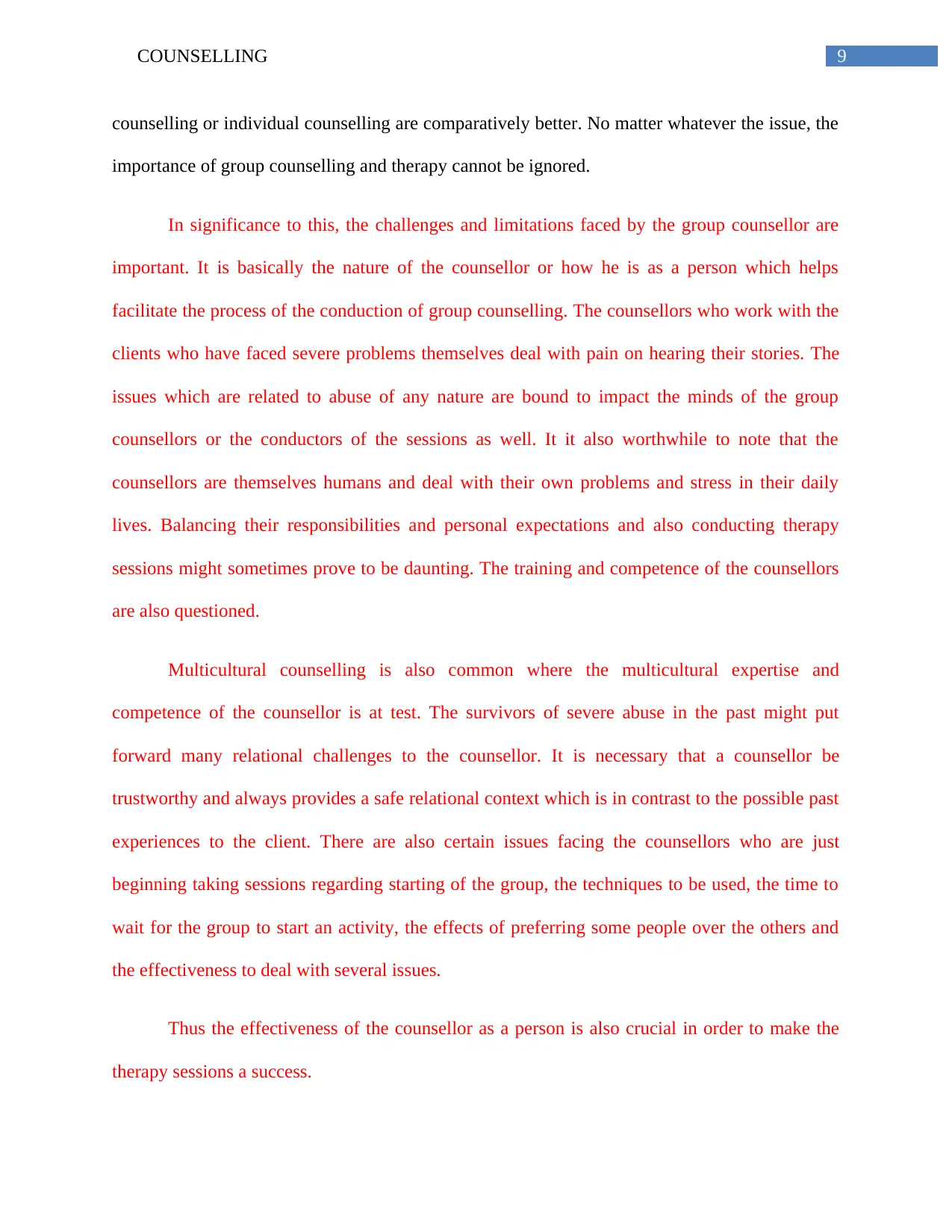
9COUNSELLING
counselling or individual counselling are comparatively better. No matter whatever the issue, the
importance of group counselling and therapy cannot be ignored.
In significance to this, the challenges and limitations faced by the group counsellor are
important. It is basically the nature of the counsellor or how he is as a person which helps
facilitate the process of the conduction of group counselling. The counsellors who work with the
clients who have faced severe problems themselves deal with pain on hearing their stories. The
issues which are related to abuse of any nature are bound to impact the minds of the group
counsellors or the conductors of the sessions as well. It it also worthwhile to note that the
counsellors are themselves humans and deal with their own problems and stress in their daily
lives. Balancing their responsibilities and personal expectations and also conducting therapy
sessions might sometimes prove to be daunting. The training and competence of the counsellors
are also questioned.
Multicultural counselling is also common where the multicultural expertise and
competence of the counsellor is at test. The survivors of severe abuse in the past might put
forward many relational challenges to the counsellor. It is necessary that a counsellor be
trustworthy and always provides a safe relational context which is in contrast to the possible past
experiences to the client. There are also certain issues facing the counsellors who are just
beginning taking sessions regarding starting of the group, the techniques to be used, the time to
wait for the group to start an activity, the effects of preferring some people over the others and
the effectiveness to deal with several issues.
Thus the effectiveness of the counsellor as a person is also crucial in order to make the
therapy sessions a success.
counselling or individual counselling are comparatively better. No matter whatever the issue, the
importance of group counselling and therapy cannot be ignored.
In significance to this, the challenges and limitations faced by the group counsellor are
important. It is basically the nature of the counsellor or how he is as a person which helps
facilitate the process of the conduction of group counselling. The counsellors who work with the
clients who have faced severe problems themselves deal with pain on hearing their stories. The
issues which are related to abuse of any nature are bound to impact the minds of the group
counsellors or the conductors of the sessions as well. It it also worthwhile to note that the
counsellors are themselves humans and deal with their own problems and stress in their daily
lives. Balancing their responsibilities and personal expectations and also conducting therapy
sessions might sometimes prove to be daunting. The training and competence of the counsellors
are also questioned.
Multicultural counselling is also common where the multicultural expertise and
competence of the counsellor is at test. The survivors of severe abuse in the past might put
forward many relational challenges to the counsellor. It is necessary that a counsellor be
trustworthy and always provides a safe relational context which is in contrast to the possible past
experiences to the client. There are also certain issues facing the counsellors who are just
beginning taking sessions regarding starting of the group, the techniques to be used, the time to
wait for the group to start an activity, the effects of preferring some people over the others and
the effectiveness to deal with several issues.
Thus the effectiveness of the counsellor as a person is also crucial in order to make the
therapy sessions a success.
Paraphrase This Document
Need a fresh take? Get an instant paraphrase of this document with our AI Paraphraser
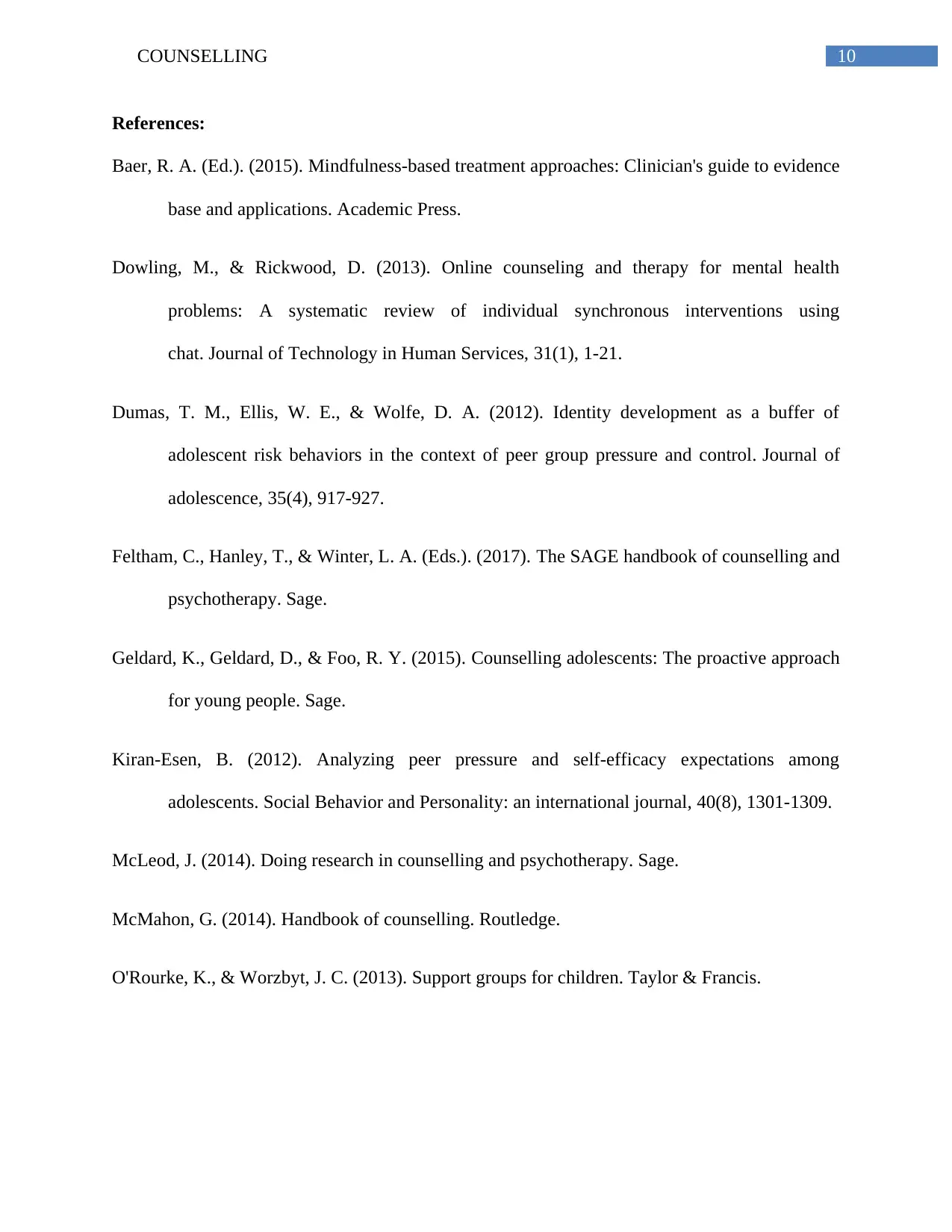
10COUNSELLING
References:
Baer, R. A. (Ed.). (2015). Mindfulness-based treatment approaches: Clinician's guide to evidence
base and applications. Academic Press.
Dowling, M., & Rickwood, D. (2013). Online counseling and therapy for mental health
problems: A systematic review of individual synchronous interventions using
chat. Journal of Technology in Human Services, 31(1), 1-21.
Dumas, T. M., Ellis, W. E., & Wolfe, D. A. (2012). Identity development as a buffer of
adolescent risk behaviors in the context of peer group pressure and control. Journal of
adolescence, 35(4), 917-927.
Feltham, C., Hanley, T., & Winter, L. A. (Eds.). (2017). The SAGE handbook of counselling and
psychotherapy. Sage.
Geldard, K., Geldard, D., & Foo, R. Y. (2015). Counselling adolescents: The proactive approach
for young people. Sage.
Kiran-Esen, B. (2012). Analyzing peer pressure and self-efficacy expectations among
adolescents. Social Behavior and Personality: an international journal, 40(8), 1301-1309.
McLeod, J. (2014). Doing research in counselling and psychotherapy. Sage.
McMahon, G. (2014). Handbook of counselling. Routledge.
O'Rourke, K., & Worzbyt, J. C. (2013). Support groups for children. Taylor & Francis.
References:
Baer, R. A. (Ed.). (2015). Mindfulness-based treatment approaches: Clinician's guide to evidence
base and applications. Academic Press.
Dowling, M., & Rickwood, D. (2013). Online counseling and therapy for mental health
problems: A systematic review of individual synchronous interventions using
chat. Journal of Technology in Human Services, 31(1), 1-21.
Dumas, T. M., Ellis, W. E., & Wolfe, D. A. (2012). Identity development as a buffer of
adolescent risk behaviors in the context of peer group pressure and control. Journal of
adolescence, 35(4), 917-927.
Feltham, C., Hanley, T., & Winter, L. A. (Eds.). (2017). The SAGE handbook of counselling and
psychotherapy. Sage.
Geldard, K., Geldard, D., & Foo, R. Y. (2015). Counselling adolescents: The proactive approach
for young people. Sage.
Kiran-Esen, B. (2012). Analyzing peer pressure and self-efficacy expectations among
adolescents. Social Behavior and Personality: an international journal, 40(8), 1301-1309.
McLeod, J. (2014). Doing research in counselling and psychotherapy. Sage.
McMahon, G. (2014). Handbook of counselling. Routledge.
O'Rourke, K., & Worzbyt, J. C. (2013). Support groups for children. Taylor & Francis.
1 out of 11
Related Documents
Your All-in-One AI-Powered Toolkit for Academic Success.
+13062052269
info@desklib.com
Available 24*7 on WhatsApp / Email
![[object Object]](/_next/static/media/star-bottom.7253800d.svg)
Unlock your academic potential
Copyright © 2020–2025 A2Z Services. All Rights Reserved. Developed and managed by ZUCOL.




